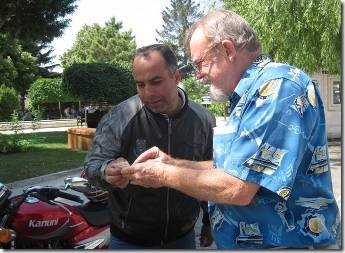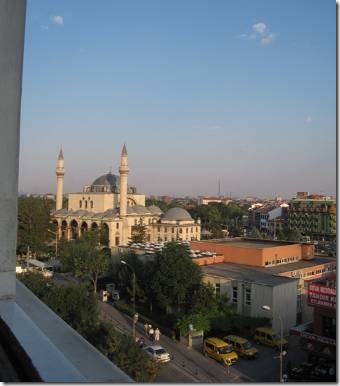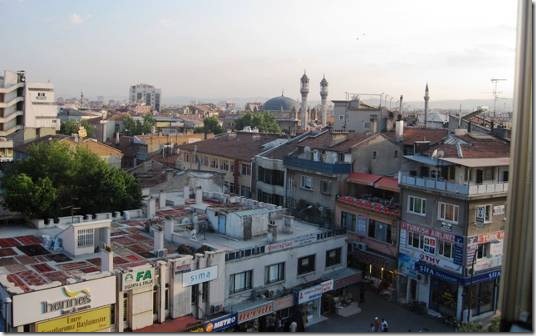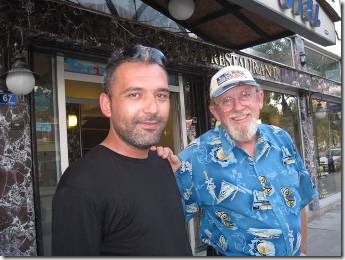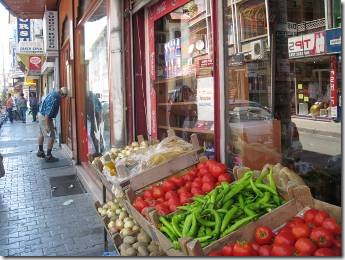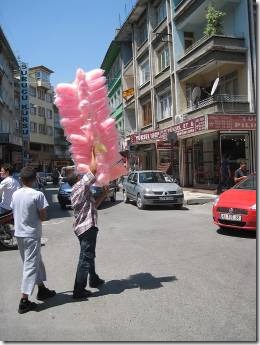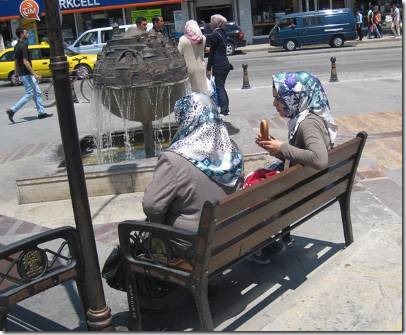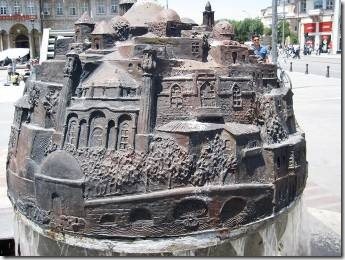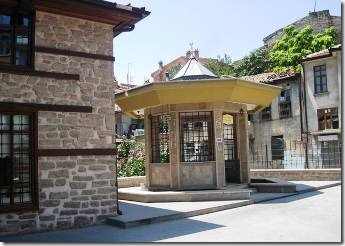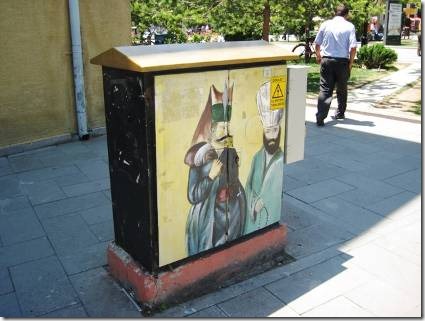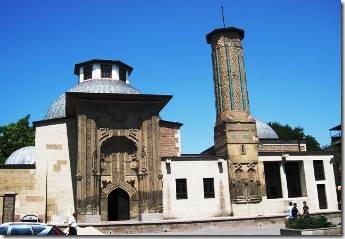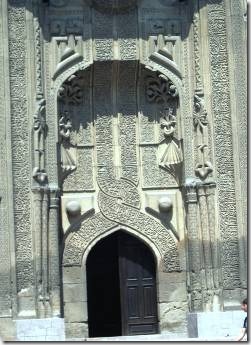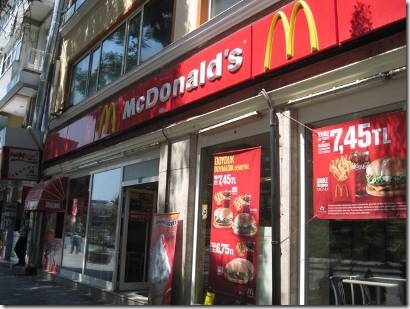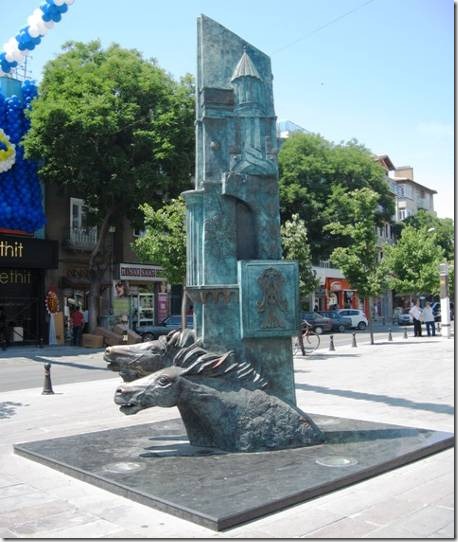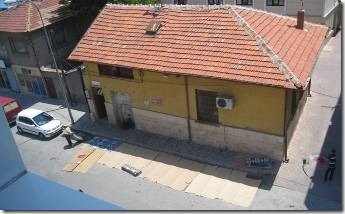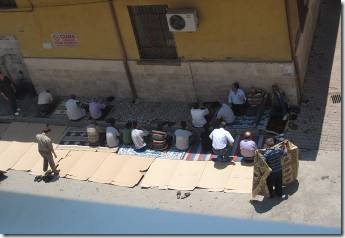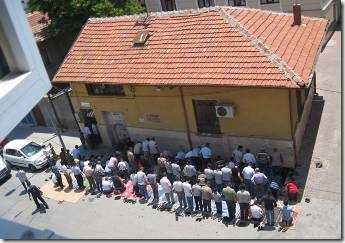“Turkey’s equivalent of the “Bible Belt,” Konya treads a delicate path between its historical significance as the home town of the whirling dervish orders and a bastion of Seljuk culture on the one hand, and its modern importance as an economic boom town on the other.
The city derives considerable charm from this juxtaposition of old and new. Ancient mosques and the mazy market district rub up against contemporary Konya around Alaaddin Tepesi, where hip-looking university students talk religion and politics in the tea garden.”
From about 1150 to 1300 Konya was capital of Seljuk Sultanate of Rum, which encompassed much of Anatolia*. The Seljuk sultans endowed Konya with dozens of fine buildings in an architectural style that was decidedly Turkish but had its roots in Persia and Byzantium.”
Lonely Planet 2009
I’ve just spent the past hour trying to come up with some easy explanation for the term Anatolia in today’s usage. I have heard cruisers refer to Turkey as Anatolia. Lonely Planet doesn’t include all of Turkey in the areas it describes as Western, Central, Northeastern and Southeastern Anatolia. I think Anatolia was once larger than modern Turkey but did it include all of what is now modern Turkey? As for the Seljuks, I think they are the ancestors of the people who are now modern Turks.
*Anatolia is roughly contiguous with the Asian portion of the modern Republic of Turkey. http://www.anatolia.com/anatolia/
*Anatolia (from Greek Ἀνατολή Anatolē — "east" or "(sun)rise"; also Asia Minor, from Greek: Μικρὰ Ἀσία Mikrá Asía "small Asia"; in modern Turkish: Anadolu) is a geographic and historical term denoting the westernmost protrusion of Asia, comprising the majority of the Republic of Turkey. http://en.wikipedia.org/wiki/Anatolia
http://eudo-citizenship.eu/docs/CountryReports/Turkey.pdf seems to be a pretty interesting explanation of Turkish ethnography for those really interested.
Our motorbiking guide Ibrahim Eauzun who took the time to lead us to our hotel through the traffic of Konya.
Remember the scene in the Wizard of Oz when Dorothy and her companions look off into the distance and there’s Oz. We’ll that’s what Konya looked like to us coming down from the country road that we’d followed from Beysehir to the huge city of close to 1,000,000. It was nice to have a guide.
Looking over “Ottoman Konya” at dusk.
Our first night we ate dinner in a hotel restaurant overlooking Konya.
The red oblongs on the roof of the building are Turkish carpets. I read that sunlight can kill certain “dark and damp” loving bugs. You see carpets out being aired everywhere and no one seems to worry about fading. From these two photos it’s obvious that minarets dominate the skyline.
Yuksel Arslan
Though his goal was to sell us carpets, Yuksel took us under his wing and walked us through “mazy” Konya to a motorbike repair shop so Randal could ask about having the oil changed on our motorbike. Randal was told to return after prayers so he and Yuksel made a plan to meet at 2pm and return to the shop. Yuksel would go along to act as interpreter since no one in the shop spoke English. I stayed in our hotel room reading up about Konya, doing lots of hand laundry and relaxing. As a thank you, Randal invited Yuksel to dinner with us, and though he did join us and drank a couple of beers, it wasn’t his dinner time. (We met him at 6:30 but many people eat later after the heat of the day.) Yuksel directed us to a hotel restaurant where we had those lovely views overlooking the city, great meze, perfectly cooked fish and while the guys had beer, I had my small glass of raki. You can order it in 3 different amounts and I always order the smallest and that’s enough.
Small neighborhoods within the big city where you can buy your fruit and veggies or my favorite, cotton candy though I resisted.
Enjoying a simit.
More women wore head scarves here than I’d seen around the coastal areas and Istanbul. All 4 women I caught in this photo have their heads covered and also their arms covered. I wore my longest mid-shin pants and a shirt with puffy sleeves that at least covered my shoulders and I always carried a shawl.
I have also grown addicted to simit, a less doughy, soft but crusty sesame seed covered bagel/unsalted real ball game pretzel.” I eat them plain, not warmed, toasted or covered with or stuffed with anything. I eat them just the way this woman is eating hers. I’m having one with some white Turkish wine as I type this now. They are so good!
A close up of the fountain which looks a bit like a representation of Konya.
The small octagonal building next door to the stone mosque is a WC (public toilet.) The toilets are below ground with a sitting area and sinks above for washing before prayers. Most charge 1 TL but are kept clean. As we traveled inland I found mostly squat toilets which I can deal with but aren’t my first choice. I have learned to open each of the stall doors because often hidden behind one is a sit down toilet.
Electrical boxes have been turned into works of art.
“On the western side of the Alaaddin Tepesi ring road is the İnce Minare Medresesi (Seminary of the Slender Minaret), now the Museum of Wooden Artefacts & Stone Carving. This religious school was built in 1264 for Sahip Ata, a powerful Seljuk vizier, who may have been trying to outdo the patron of the Karatay Medresesi, built only seven years earlier.
The extraordinarily elaborate doorway, with bands of Arabic inscription running all round it, is far more impressive than the small building behind it. The octagonal minaret in turquoise relief is over 600 years old and gave the seminary its popular name. If it looks a bit short, this is because the top was sliced off by lightning in 1901.”
http://www.lonelyplanet.com/turkey/central-anatolia/konya/sights/museum/museum-wooden-artefacts
We didn’t go into the museum because we were on our way to the Ataturk Museum. We were planning to attend the 9 pm dervish performance that evening and didn’t want to be too tired from trying to do too much during the day.
But we did stop next door: Burger, fries and a Coke cost 7.45 TL about $4.50
Randal had a lemon milkshake and I had Coke light. We had visited the Mevlana Museum and walked over Alaaddin Hill and were on our way to the Ataturk House Museum when we stopped for a snack. The McDonald’s manager was very helpful telling us about the building next door and translating the milkshake flavors for Randal. He chose lemon anyway. We finally got to the Museum and it was closed for renovation something the Konya Tourist Office had failed to mention. I hadn’t specifically asked but you’d think they would have pointed that out, Ataturk being the national hero and all. And it wasn’t as if it had just closed that morning. It looked like it had been closed for a while. The man who had finally come out from the museum to see who was trying to break in spoke little English and was mostly interested in making us go away. Ataturk is a very important part of modern Turkey and I had really wanted to visit the museum. Bulent and Mayor Gozgun would have let us in or made some effort or at least have acted sorry at our disappointment. I guess we were surprised that everyone didn’t treat us that way, though most people did so that’s why we were surprised when some people weren’t helpful.
A modern sculpture that I like but can’t remember what it was all about. I just liked the horses. It was down the street from the “closed for renovation” Ataturk Museum. This street also had lots of high end clothing shops and computer and appliance shops.
We arrived in Konya on Friday and were in our room at the Otel Derya when I noticed men gathering just outside our window. Our hotel room overlooked a Friday mosque (I think that’s what it was,) where men gather to pray. This was the scene before the prayers began and again after prayers.
Cardboard is placed to protect the prayer rugs.
Some men put down large carpets to share and others had individual prayer rugs.
Those in the sun must have been quite hot.
These photos were taken on Friday, the day we arrived and Saturday during the day. We attended the free Whirling Dervish performance Saturday evening. Photos from that performance and our visit to St. Paul Church Saturday afternoon will be the next email.
Ru
Doramac

